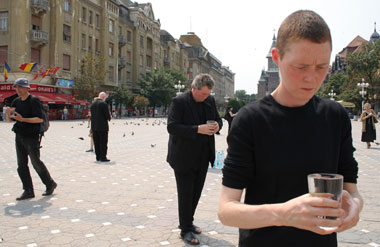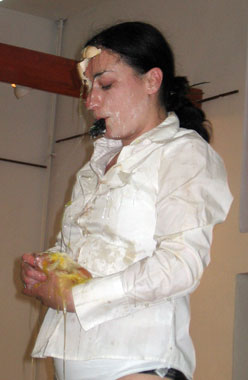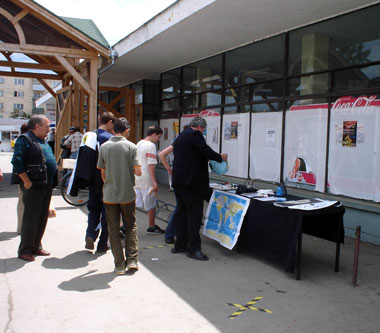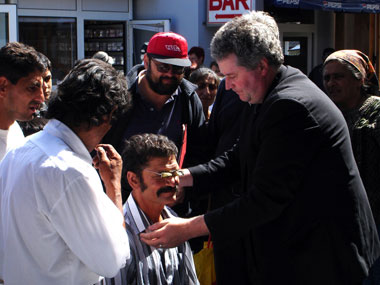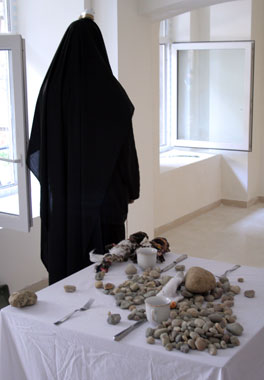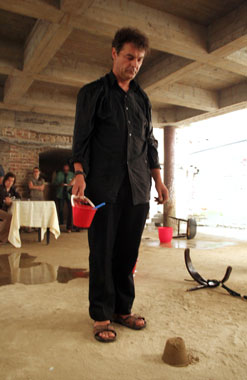Below are three articles covering a performance-art fortnight at which a significant group of artists based in Northern Ireland were active participants. The events took place in Sepsiszentgyörgy, Saint Ann Lake and Timișoara the Transylvania region of Romania in July 2006.
In memoriam Imre Baász (1941-1991)
At the beginning of the nineties I started the ARES Artist-in-Residence Program of the ETNA Foundation, in order to present the outstanding action-artists of the world to the local audience whose interest in living arts was shaped by the AnnART Festivals. That’s how I managed to invite Roddy Hunter, the Scottish artist from Glasgow. Using the pseudonym Cylinder, he did a 36-hour performance in the local Art Gallery. Julie-Andree Tramblay, the young and energetic artist from Montreal, visited us in February 1998; she created works in the Art School, in the theatre hall. During the same year we were able to host Roland Miller, the world-famous action-artist from Sheffield, England. On 17 May, 1999, Eugen Cosoreanu, Cosmin Pop and Sándor Stransky from Kolozsvár, Romania, were the guests of the ARES-program; we exhibited their Music Pub posters in the local Art Gallery. In April 2000, István Bertalan gave a lecture and projected videos about the activity of the quondam Sigma Group from Temesvár, Romania, in the local Art School. In the same year, Julie Bacon, Helen McBride, Imre Bukta and Roddy Hunter made several public and private performances in our town. In August, Elisabeth Fisher (Vancouver) prepared a series of charity actions, which started from an authentic World War II story related to our region. At the beginning of December 2002, the artists Lorena Mendez (Mexico) and Fernando Fuentos (Texas, USA) honoured us with their presence and their interactive, symbolic actions. In July, August and September 2003, Kenny McBride presented his performances in Sepsiszentgyörgy and in Kézdivásárhely, and as a result of the time spent here he wrote his Masters thesis about the local characteristics of the genre, with respect to Mikhail Bakhtin’s theses. In November, the Japanese artist Yudai Hashimoto created installactions at the Soviet Heroes’ Monument and in the café called Esti Kornél. Sinéad O’Donnel from Ireland researched in the ETNA Foundation’s archive during July and August 2004, then she presented an impressive process-work in Míves Ház’s ETNA Room. Before leaving she promised she would visit us again.
Sinéad O’Donnell did return, but this time not alone. Thanks to her enthusiastic and ambitious work, she managed to receive funding from the British Council. The seven artists participating in the project – each of them representative, performing artists of their regions – arrived at Sepsiszentgyörgy in the middle of July. They were accommodated in the local government’s guestroom in the county council’s guesthouse (the former Villa); their meals were provided by the Triebel and Bastion restaurants. (Thanks for this to the mayor’s office, to the president of the county council and to the restaurant owners.)
My grand-opening speech took place after 5 o’clock on the first day, then the ARES Action Group, especially founded for this event, carried out Marylin Arsem’s (Bostonian performance art teacher) action entitled Marilyn 1. They walked repeatedly through the room holding identical glasses full to the brim with water, taking care not to let the water spill. If that did happen nevertheless, the procedure started all over again, until exhaustion.
I started my own action, Crown-cap dance, in the Phare room, sitting down among the audience. I took out several pounds of caps from a bag, naming them one by one. I stood up then, very slowly, as I had magnets fixed on my leg, and he started dancing in steady tempo a boys’ folk dance from Transylvania. After crossing the room I got faster and faster, thus getting rid of my attachments’, accompanied by the jingling sound of the caps.
Sinéad O’Donnell’s action, I love mamaliga – I hate puliszka – I love mamaliga – I hate puliszka, based on linguistic and gesticulatory symmetry, emphasized twoness as a local characteristic. She stirred flour on a table with both her hands, savouring the Romanian and Hungarian names of the national food. A strident sound-poem complicated to chaos, supported by radio blanketing.
Barnabás Vetró’s sound-based work, Warmed up, took place in the Míves Ház hall. After a short tone-up, he flew a peculiar-shaped wooden object tied with rope for a precisely calculated time. The piercing sound of the rolling ‘instrument’ conferred a poetic touch to the work.
Krisztina Szabó from Kézdivásárhely drilled several holes into the asphalt sidewalk just in front of Míves Ház Hall, wearing a cowboy hat and adjusting her gestures to the role; then she planted grass into each hole, pointing at the frequent uselessness of our deeds.
The next work was Attila Toró’s Trust training : in the twilight he lay down on his back and bit into apples under threatening knives hovering above him. Because of ultraviolet light, price-tags on his body radiated like glow-worms, creating the atmosphere of a mysterious ritual.
On 19 July we left on a trip, with the help of the Sepsiszentgyörgy Mayor’s Office. We visited the Village Museum in Csernáton, then we had lunch in Kézdivásárhely. The next stop was a mineral-water basin in Bálványos. Here I used two pearls from Elina Hartzell’s work of the previous day, with dates on them. As a static action, I stood in the water up to my knees, and touched the surface with the pearls fixed on leaves of grass, thus emphasizing the water flow. Then I passed the pearls to the other participants, thus involving everybody in the actions, they shared a mystical ritual that showed respect to the power of space.
The last action was performed by Attila Toró; his repetitive Symbiosis was based on his own physical condition and stones, making an allusion both to his works carried out at the lake in the nineties and to the possibilities of co-existing with nature.
The atmosphere of the farewell party, the joyful conversation between the guests and the hosts, the well-done two-day series of actions, meant common work and common joy for all of us. As a bonus, the next day the artists left to the Banat region, on the way there visiting the Black Church in Kronstadt. The series of actions continued in Temesvár, organized by the art historian Ileana Pintilie and two former students of mine, Levente Kozma and Domokos Váncsa, under the patronage of Simultan.
Gusztáv Ütö is an artist and co-organiser of ARES 2006.
ARES is an artist-run performance art’ residency that is organised annually by Gusztav Ütö, founder of the ETNA Foundation Action Art Archive. It is located in the town of St George / St Gheorghe / Sepsiszentgyörgy. It was born out of a long-awaited artistic freedom. It is a residency that openly and courageously invites artists to be free. Under the umbrella of the ETNA Foundation, and with the support of the British Council in both our countries, ARES expanded its ideology by inviting seven artists based in Northern Ireland, who have been working in performance practice for up to three decades, to make original live works, impromptu and fixed, across the Transylvanian region of Romania. This event involved many artistic manoeuvres and collaborative negotiations. The co-ordinators of this project were Ileana Pintilie, Levente Kosma and Gusztav Ütö. I will focus here on the works that were made by the artists that travelled from Northern Ireland at locations in the town of St George and at St Ann Lake.
Artists that participated in this exchange were Hanna Kolumbán, Kristina Szabó, Attila Toró, Gusztáv Ütö, Barnabas Vetró, Elina Hartzell, Brian Connolly, myself (Sinéad O’Donnell), Hugh O’Donnell, Sandra Johnston, Brian Patterson and Prof Alastair MacLennan.
‘The sun came out for us that day – In memoriam Imre Baász’
Connolly began in the market place in St George: his work was titled Market stall. For the duration of the day, he was at his travelling market stall, one filled with objects intended for interaction whose design promoted a visual curiosity. His work humorously approached the current politics of economy and territory. As the people gathered over the course of the day, they could buy old second-hand hens’ teeth or a piece of the moon or the world from maps. The European countries were overpriced, going for €200 – 250, or you could settle to buy an inch for 10 Romanian Lei, which is about 25 cents.
One could try on his Virtual reality goggles, an object that Connolly designed to share a visual moment with others. These temporal intimacies, optical and conceptual, attempted to open up the mind and recognize an individual’s struggle to see the world. It was a social action that seemed to be, through their response, agreeable to the audience. He embodied the persona of a travelling salesman, a magician, a middleman, an outsider, and a negotiator. Romania, at that time, sat on the cusp of European Union membership. This was an action that the public could connect with, successfully inviting a tactile experience from the viewers.
Meanwhile, in the park, MacLennan simultaneously made a work, Face afar, from 11:00am to 4:30pm. In his meditative way, he created an ambience that day. He sat with a large piece of white cloth covering his head and body, his posture still, a man’s shoe balanced on his head. There was a table in front of him. The table was filled with soil, debris, dismantled doll parts, crockery, knives and forks.
I felt confusion as to the place of this man at this table. It wasn’t a place of meeting, communication, or nurturing in the traditional sense. Some people watched him from a distance; some approached him to get a closer look. Was he real? A little girl stood and studied him, becoming more interested in the dolls.
What became more apparent to me was the effectiveness of duration. Time as material’ opened up questions of practice from an artistic point of view about the relationship between body and action. Was this an inflicted body? A political body? A religious body? A private body? A social body? A public body? MacLennan’s location in the park was surrounded by monuments. The white cloth became empowered in comparison to the material of the cemented statues. The dynamics of power shifted for me, and he became a living statue. The monumental and the social body connected. The men, women and children who were on the ground that day, an incidental audience, were temporal and ephemeral in their shared experience through MacLennan’s performance.
Maclennan and Connolly were the durational pillars of events in St George that day. As the sun moved across the park, Hartzell began at the Lions Stairs/ Lykopene, a set of steps that lead down into the park. She positioned herself at the top of the steps facing the two stone lion heads. Slowly, creating a tension as she moved, she backed down the steps while holding a handmade pearl necklace, brought from home. The necklace was large and detailed with birth and death dates from her loved ones and guest and host artists. Gradually, she released the necklace beads one at a time with each step. They scattered along the ground throughout the park. Hartzell’s movement was in a straight line. I watched the significance of the material change, from the beads being strung together, to having the necklace taken apart. The action stopped when she reached the meeting point between the park and the main road, ending on a threshold.
Not too far away, Patterson called our attention with a hand bell. His performance, Sublimation St. George, began at the Mihai Viteazul statue. Taking his time to settle into his action, he spread seeds from his bag, germinating the nearby flowerbeds. He then produced two large stones, one from home and one from the Black Sea. Rolling the rocks in front of him, he took us on a journey through the park, towards the ETNA Foundation. By the rolling the stones, Patterson was manipulating the process of erosion. He humorously played with the interjections of power by taking two red roses from his bag and tickling the noses of two stone-faced lions inset in the park. This stance reversed a little when he belly-crawled, pushing the rocks in front of him. Patterson’s action was thoughtful in its struggle and marked a particularly manmade territory. Once he reached the street, his action continued and met a waiting local audience.
Continuing into the night, all artists opened the action art meeting with theARES Group Action, Marilyn 1. It is an action that was invented originally by American artist Marilyn Arsem. This action occurred three times and could briefly be described as a decided single action, with common material performed by all artists in the same location within a framed time. It effectively integrated artist with artist and identified a common ground for the artist and the audience. The second group action took place at the formerly volcanic St Ann Lake. Extemporaneously and in line with nature, Connolly, in his black suit, floated on top of the lake, blowing bubbles that drifted across the water. Simultaneously, all artists submerged themselves knee or waist high in the water. These actions at the lake were something of a chain reaction. Harztell, Johnston and Hugh O’Donnell all made independent works.
O’Donnell put a colourful cloth across his face, blindfolding himself, signalling that he was making an action. At the edge of the lake he felt his way around his materials, proceeding to make a large bundle of bound sticks. Attaching a rope to the end of them, he blindly thrust them repeatedly into the water, Faggot fishing. O’Donnell’s playful, yet extremely challenging research into the stereotypical opinion and patriarchal restraints that have suppressed homosexuality in Ireland was admirable. There was no sense of time during his performance, only a captivating exchange of thought and action between O’Donnell and the lake.
In the place of O’Donnell, Johnston began to undress, appearing like a swimmer in her underwear for her action, Some who couldn’t. Lying belly down on the wooden platform at the edge of the lake, she moved into a difficult position. Her arms and legs moving in the same direction behind her, she raised her legs to balance and hold a glass of water from the lake in between her feet. Johnson’s action was comfortably five minutes. Her body became a distinction between recognisable barriers and obvious transparencies, producing a fusion that incorporated material, presence, spontaneity and responsibility.
It was translated for me that the public, picnicking at the lake, were saying “Look! Artists are making performance at the lake again." The lake was the site for Eastern Europe’s largest outdoor performance art meeting, AnnArt, which ran for 15 years, in secret before 1989.
ARES legitimised and recognised performance practice in this region. It acknowledged the growing demand for new crossovers in methodologies, creating new spaces and locations for artists to meet and make work, alternatively educating through performance art. It gave us an opportunity to understand and develop intercultural / artistic relationships for the future between our two countries.
I wish you were here, where the artist and audience share common ground
Sinéad O’Donnell is an artist and was a co-organiser of ARES 2006.
As part of the residence program for performer artists, initiated in Sf. Gheorghe (Romania) by the Etna Foundation and especially by the well-known performer Gusztáv Ütö, in the summer of 2006, an exchange project between Irish and Romanian artists was started. The residence program, entitled ARES, became thus an international one, supported financially by the British Council. The documentation trip and the establishment of the contact with the corresponding Romanian mileu was organised in Sf. Gheorghe and Timișoara and included Sinéad O’Donnell, as well as Alastair McLennan, Sandra Johnston, Brian Patterson, Brian Connolly, Elina Hartzell, and Hugh O’Donnell. The Irish artists visiting Timișoara were supposed to be accompanied by Gusztáv Ütö, Hanna Kolumbán, Krisztina Szabo, Attila Toró, and Barnabas Vetro. Unfortunately, the group could not be reunited entirely, being represented only by Gusztáv Ütö, who also carried out the absentees’ projects.
In Timișoara, the performance artists were welcomed by Levente Koszma, representing the Simultan Foundation, and by myself, Ileana Pintilie from The Zone performance festival, and the events were partially organised in the streets and the city’s public squares, partially on the premises of the 1989 Revolution Memorial, generously offered by the coordinator of the Foundation, Mr. Traian Orban.
The events organised by the visiting artists opened with a group performance entitled The Glass action 3, initiated by the American artist Marilyn Arsem and first acted out in Poland together with Alastair McLennan. In the central city square, in front of the building of the Timișoara Opera House, at noon on an extremely hot day, all the visiting artists, together with Ütö, began a static performance: each of them, very slowly, was carrying a glass full of water, a meditation on an element essential to life and very precious on those hot days. This anti-performance forced the public to stand and think, to try to attach a significance to the participants’ gestures.
The program per se started, however, during the afternoon at the headquarters of the 1989 Revolution Memorial with a lengthy performance by Alastair McLennan, entitled Team meat / Who’s missing / Down the up : in a simple, vaulted indoor space, with a decor consisting of a table laid for two, the artist – as an immobile statue, with a black veil covering his head – would, every now and then, slip several objects onto this table, such as small pebbles, then discretely inserted them into the cups. McLennan usually employs a series of symbolic elements that urge the watcher to reflect upon them, such as burnt dolls. The natural order of things and life appears thus distorted by disfigured shapes that bring about restlessness, signifying, perhaps, the loss of innocence and hope.
Parallel with this performace, which lasted several hours, Hugh O’Donnell performed I just don’t know why my feet burn and the CD doesn’t work. Disguised in a slightly comic outfit, he went out in the street barefoot, dragging behind him a wooden chair turned upside-down and holding a cassette player in his hands. After the artist had circled Union Square, trying to initiate some kind of dialogue with the scarce and weary public, exhausted by the heat (blowing a whistle, trying unsuccessfully to use the CD player, opening an umbrella to protect himself from the sun, an umbrella which ended up ‘bringing’ the rain), he came back to the Memorial together with Sinéad O’Donnell who, as a result of her performance entitled Somebody something her nothing, had gathered a crowd, through creating a ‘battle’ noise by hitting two metal receptacles against each other. The public was taken back to the general headquarters, following her as if in a sort of procession, while she was carrying a window with traces of bullets in it, a piece from the collection of the Memorial museum.
At the Memorial, in the space dug up under the inner yard, an open space though, several artists were already performing simultaneously. Sandra Johnston had begun These empty arms, an action consisting of sticking paper pieces on a wall with clay, finally setting them on fire with the help of a gas lamp. Brian Connolly, inspired by the documentaries on the 1989 Timișoara Revolution, chose a table on which he placed photocopies of various photo documents taken during the events; as he was placing photographs, candles and flowers on that table, he was also raising it gradually by means of a system made of wooden pieces attached to the table legs with vices ( House of memory; Timișoara table / Timișoara memory / Timișoara aspiration ). Elina Hartzell, seated at a table, wore several feeding bottles attached to her blouse, into which she was trying to insert metal coins ( Bani & pennies ), while Brian Patterson, in the performance entitled Sublimation – Timișoara, started by creating various small improvised actions parallel with the others’ performances. Eventually, McLennan and Gusztáv Ütö joined those who were already performing separately (though together); the latter began a series of short actions on behalf of the artists in his own team who were absent. The cumulative effect led to the creation of an overall composition, in which every part was integrated properly, especially since nature itself contributed with an unexpected shower, with water trickling down the walls and partially flooding the underground space, in a way putting an end to the group performances.
The following day, some performances were organised in Victory Square, giving the impression of free interventions in front of a Sunday public; Hartzell presented a visual performance – the artist draped vividly coloured, rainbow-like materials around her neck and chest, then sprinkled milk and cocoa on them, transforming herself into a fairy-tale-like character. Another performance was created by Sinéad O’Donnell and took place among adults and children who had come to feed the pigeons. The artist joined their group silently (Free for the birds – a part of Exposition silence) and took part in the feeding, with all the birds flying around her, to the children’s amusement. The last performance, by Johnston, was entitled And kindness, sensitively probing into a territory, in search of relics, after which the entire program closed with a discussion on the central theme of performance.
The participation of the visiting artists in the Timișoara events was a genuine feast, the performers surprising the public with the touch of unity and harmony within diversity. Their performances were sensitive, tender, slightly ironic, with a lot of sympathy and respect for the context in which they took place.
Ileana Pintilie is a professor of art, curator and art critic in the city of Timișoara, 2006
Authors: Gusztáv Ütö, Ileana Pintilie, Sinéad O’Donnell
